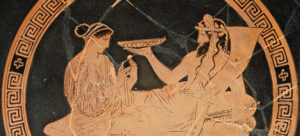Persephone was a Greek chthonic deity who is known for her dark history with her husband Hades. This story is told in the Homeric Hymn to Demeter. She is introduced in the poem as an adolescent, whose story does not begin until her abduction at the hands of Hades. Her Latin equivalent is Proserpine, whose origin story features in Ovid’s Metamorphoses. Persephone was known as the daughter of the agricultural goddess Demeter and the head of Olympus, Zeus. She was worshipped in her own right in relation to agriculture and fertility.
The abduction of Persephone has been described as a variety of things, ranging from a rape to a marriage. A distinction is made between rape and marriage in the descriptions found in the Greek and Latin accounts. The Greek authors describe the event as an abduction as they have no explicit reference to a sexual assault. However, the Latin authors focus on the sexual aspects of the encounter and show it as an example of rape. There are many signs through the Greek Hymn which point towards the abduction of Persephone being the execution of an arranged marriage. The Hymn suggests that this marriage had been predetermined by her father Zeus, rather than Hades acting on his own accord. As in most cultures, the daughters of ancient Greece were predominantly considered to be the property of their fathers. Marriages were arranged between the father of the bride and the groom; with the consent of the bride being essentially irrelevant. The Homeric narrative paints Persephone’s abduction as being the beginning of a marriage ceremony between the two Underworld deities. During her time with Hades, she eats four seeds of a pomegranate causing her to remain tied to the Underworld for eternity. These seeds have caused controversy in academia, as the middle of the Homeric Hymn shows Persephone eating the seeds of her own accord. However, when she later tells Demeter of her journey she states that Hades compelled her to eat them. After searching the earth for her daughter, Demeter returns to Olympus to beg Zeus to return Persephone to her. He declared that as Persephone had eaten the pomegranate seeds, she must remain in the Underworld for the same amount of time as the number of seeds each year. After this, she would be free to spend the remainder of the year with Demeter. Greek myth shows Persephone returning for 8 months out of every 12 which shows this to be how the seasons were interpreted. Her 4 months in the Underworld would result in winter and the death of crops and agriculture. Latin mythology differs, with Prosperine eating 6 seeds and thus spending 6 months in the Underworld.
Persephone was celebrated in the annual Greek festival of Thesmophoria. This festival was for married Greek women and was recorded in the Thesmophoriazusae by Aristophanes. One of these was ‘Nesteia’, or fasting in a bid to not only enhance the harvest in their region, but also to boost their own fertility. Persephone is also the deity worshipped in connection with the Eleusinian Mysteries. This religious organisation held secret rites to celebrate her annual return. Initiates in the Mysteries were believed to have access into Persephone’s Grove in the Underworld. The Grove was an area considered to be paradise in the afterlife.
Persephone is an interesting deity, as she is known for bringing life and providing fertility to the earth. She is also known for her strong association to the Underworld and death. It is this link to the afterlife that has resulted in her invocation on items such as the Orphic Gold Tablets and the Curse Tablets. Her dual personality is fascinating as the ancient Greeks were able to appeal to either side of her.
-Devon Allen
Junior Girl
Girl Museum Inc.

